As if losing Harold Ramis on Monday wasn’t enough, genre fans get another kick in the teeth, though perhaps not as high-profile as Ramis. Frequent-flyer Star Trek director Cliff Bole left us on February 15th, though word only leaked out to fandom today. With its very fixed lighting grid and the extremely limited setups afforded by sets that were not built “wild” (i.e. chunks of the set could be wheeled out of place to offer a perspective that would be impossible with a solidly-built three-or-four-wall set), Star Trek: The Next Generation was, perhaps, not the best showcase for a director. You had a week to prep, you had an ensemble cast who would undoubtedly tell you – though kindly – that they didn’t really need direction as such, and you had a monolithic, unmovable central set with bright, even lighting. Now what? Cliff Bole was one of a handful of Trek directors who managed to stand out without blowing out the budget or honking off the cast (two things that would likely prevent any director from becoming the recurring fixture that Bole was).
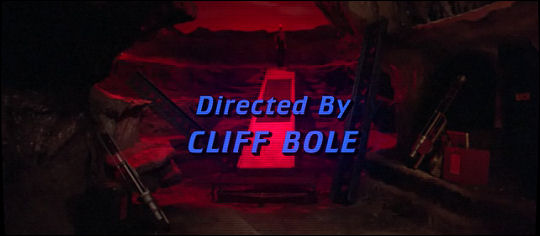
Here are my recommendations for ten of his best that aren’t The Best Of Both Worlds: episodes that he managed to rock despite limited resources and the show’s admittedly limited playbook.
Lonely Among Us – one of the show’s earliest “weird” episodes, this one was almost like an episode of an anthology series like The Twilight Zone or The Outer Limits. 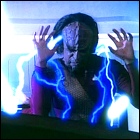 In both script and visual style, it just tastes un-Star-Trek. It was also six weeks in to the first season, when the show’s stylistic parameters were still up for grabs. As such, there are marvelously moody dark scenes, Patrick Stewart being legitimately scary in places, and unusually weird alien guest stars getting to do stuff that was actually alien, rather than the later TNG trope of “embodying a particular foible of humanity while wearing the smallest and yet most prominent prosthetic forehead enhancement the makeup department can cook up.” On the flipside, there’s Dr. Crusher’s never-worn-again-and-with-good-reason 24th century “doctor hat”, and the episode being brought to you by the letter P. This one tends to get lost in fandom’s collective memory because of the sheer amount of weirdness on display. Looking back, that weirdness makes it a standout in that uncertain first season. I actually wish he’d gotten to do The Best Of Both Worlds more like this.
In both script and visual style, it just tastes un-Star-Trek. It was also six weeks in to the first season, when the show’s stylistic parameters were still up for grabs. As such, there are marvelously moody dark scenes, Patrick Stewart being legitimately scary in places, and unusually weird alien guest stars getting to do stuff that was actually alien, rather than the later TNG trope of “embodying a particular foible of humanity while wearing the smallest and yet most prominent prosthetic forehead enhancement the makeup department can cook up.” On the flipside, there’s Dr. Crusher’s never-worn-again-and-with-good-reason 24th century “doctor hat”, and the episode being brought to you by the letter P. This one tends to get lost in fandom’s collective memory because of the sheer amount of weirdness on display. Looking back, that weirdness makes it a standout in that uncertain first season. I actually wish he’d gotten to do The Best Of Both Worlds more like this.
Conspiracy – the penultimate episode of the first season, Conspiracy is maddening from a story standpoint. Holy crap! An attempt to invade the Federation by subterfuge, and worse yet, they’ve sent a homing signal and they’ll be back! Except, of course, that they never came back. Maybe it was the collective thump of 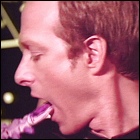 station managers demanding that nothing like the horrific exploding-head effect ever hit their airwaves again. Maybe it was the collective snicker of everyone who realized that the alien life form that almost toppled Starfleet from within was represented by Claymation. Or maybe it was the studio, hoping to syndicate the show in no particular running order, breaking out in a cold sweat over the thought of serializing a show that was a hard sell enough as it was (being the syndicated sci-fi sequel that it was). Bole imbues this story with some real menace (if anything, the planet scenes early on are lit so relentlessly red that maybe he overdid it), and the action scenes are pretty solid. And holy crap, live maggots for dinner and exploding heads… still one of my favorite TNG segments for how unsettling it all was at the time.
station managers demanding that nothing like the horrific exploding-head effect ever hit their airwaves again. Maybe it was the collective snicker of everyone who realized that the alien life form that almost toppled Starfleet from within was represented by Claymation. Or maybe it was the studio, hoping to syndicate the show in no particular running order, breaking out in a cold sweat over the thought of serializing a show that was a hard sell enough as it was (being the syndicated sci-fi sequel that it was). Bole imbues this story with some real menace (if anything, the planet scenes early on are lit so relentlessly red that maybe he overdid it), and the action scenes are pretty solid. And holy crap, live maggots for dinner and exploding heads… still one of my favorite TNG segments for how unsettling it all was at the time.
The Royale – the stories about this episode are legendary. Everyone behind the scenes seemed to know they were lining up a barely-cooked turkey for the public’s consumption. The writer took his name off of the credits (so you 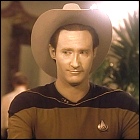 know: “Keith Mills” was a pseudonym for future Sliders creator Tracy Torme). And common received fan wisdom is that The Royale is a train wreck… so why is it one of the most fun shows of the second season? Bole brings some of his Vega$ playbook to the table with the (intentionally cheesy) casino melodrama scenes, overbaking those parts of the turkey to perfection. This episode works beautifully if you realize that it’s skewering entire TV genres for the fun of it. Bole nails every shot, and gets an able assist from Ron Jones’ music, which is also intentionally over-the-top and cheesy. I’m not a big fan of received wisdom, by the way. Why is A Piece Of The Action sublime comic genius if The Royale is a turkey? Simple answer: The Royale‘s better than you remember. Baby needs a new pair of shoes… and sometimes fandom needs a new pair of eyes.
know: “Keith Mills” was a pseudonym for future Sliders creator Tracy Torme). And common received fan wisdom is that The Royale is a train wreck… so why is it one of the most fun shows of the second season? Bole brings some of his Vega$ playbook to the table with the (intentionally cheesy) casino melodrama scenes, overbaking those parts of the turkey to perfection. This episode works beautifully if you realize that it’s skewering entire TV genres for the fun of it. Bole nails every shot, and gets an able assist from Ron Jones’ music, which is also intentionally over-the-top and cheesy. I’m not a big fan of received wisdom, by the way. Why is A Piece Of The Action sublime comic genius if The Royale is a turkey? Simple answer: The Royale‘s better than you remember. Baby needs a new pair of shoes… and sometimes fandom needs a new pair of eyes.
The Hunted – a great little episode where everything lines up the pins and knocks ’em down. A 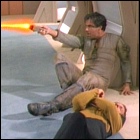 Vietnam veteran allegory worthy of the original Star Trek? Check. An ending that doesn’t confidently hand you the answer to the problem on a plate but instead challenges you to come up with your own? Check. Action staging that makes you think that the standing sets and some of the cast might not survive this week’s episode intact? Check! The scenes where Roga Danar beams aboard the Enterprise and then proceeds to make short work of his security detail (before finally being convincingly rugby-tackled by Riker and Worf) were jaw-droppingly good compared to much of TNG’s usual action staging. Though this takes us firmly into the “fixed lighting grid” era of the show that worked against director and their directors of photography getting even remotely creative with the lighting, this is still a standout episode in nearly every respect.
Vietnam veteran allegory worthy of the original Star Trek? Check. An ending that doesn’t confidently hand you the answer to the problem on a plate but instead challenges you to come up with your own? Check. Action staging that makes you think that the standing sets and some of the cast might not survive this week’s episode intact? Check! The scenes where Roga Danar beams aboard the Enterprise and then proceeds to make short work of his security detail (before finally being convincingly rugby-tackled by Riker and Worf) were jaw-droppingly good compared to much of TNG’s usual action staging. Though this takes us firmly into the “fixed lighting grid” era of the show that worked against director and their directors of photography getting even remotely creative with the lighting, this is still a standout episode in nearly every respect.
Hollow Pursuits – this was good enough on paper, but it’s beautifully directed (the holodeck scenes are some of the best comedy material that anyone 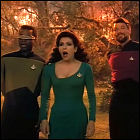 ever milked out of the TNG cast), and the casting department lucked out enough to land Dwight Schultz as Barclay. This is an episode that belongs to the cast: nothing’s going on that demands anything aside from the standard-issue lighting setup, and Bole gets the maximum laugh out of every holodeck morsel, whether it’s Tiny Riker or the look on Troi’s face when she sees how Barclay has been, er, envisioning her in the holodeck. Geordi saying “Oh. my. God.” to no one in particular is the icing on the cake – I’ve seen every episode of Cheers at least once, but it’s this scene from a Star Trek episode that I count as one of the funniest things I’ve ever seen on TV. It still makes me laugh out loud even though I’ve surely seen the thing enough times that I know what’s coming.
ever milked out of the TNG cast), and the casting department lucked out enough to land Dwight Schultz as Barclay. This is an episode that belongs to the cast: nothing’s going on that demands anything aside from the standard-issue lighting setup, and Bole gets the maximum laugh out of every holodeck morsel, whether it’s Tiny Riker or the look on Troi’s face when she sees how Barclay has been, er, envisioning her in the holodeck. Geordi saying “Oh. my. God.” to no one in particular is the icing on the cake – I’ve seen every episode of Cheers at least once, but it’s this scene from a Star Trek episode that I count as one of the funniest things I’ve ever seen on TV. It still makes me laugh out loud even though I’ve surely seen the thing enough times that I know what’s coming.
Remember Me – this one’s a guilty pleasure. The script barely hangs together, and I always felt that the weakest link in TNG’s cast was, sadly, Gates McFadden. 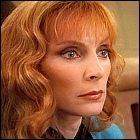 (For which I don’t entirely blame the actress: Beverly Crusher’s character outline in the series bible paints her in shades of who she is relative to Picard and to Wesley with very little about what makes the character herself tick, which is why episodes attempting to showcase her tended to be a random mess – I’m looking at you, Sub Rosa.) Remember Me is almost knee-slappingly funny in places – “If there’s nothing wrong with me, maybe there’s something wrong with the universe!” – and it completely collapses when the Traveler magically shows up to save the day, but Bole makes it damned creepy while he has the chance.
(For which I don’t entirely blame the actress: Beverly Crusher’s character outline in the series bible paints her in shades of who she is relative to Picard and to Wesley with very little about what makes the character herself tick, which is why episodes attempting to showcase her tended to be a random mess – I’m looking at you, Sub Rosa.) Remember Me is almost knee-slappingly funny in places – “If there’s nothing wrong with me, maybe there’s something wrong with the universe!” – and it completely collapses when the Traveler magically shows up to save the day, but Bole makes it damned creepy while he has the chance.
First Contact – not to be confused with the rather paint-by-numbers Borg-as-zombie-hordes 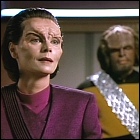 movie of the same name, First Contact is deliciously off-kilter (sometimes literally – Bole deploys some Batman-esque Dutch angles here, usually a big no-no on TNG). The story starts out from the perspective of the aliens of the week, and the Enterprise crew suddenly appears, fulfulling the role of The Other. It’s pulled off wonderfully well, momentarily making you forget that Patrick Stewart & co. are who we’re actually meant to be following from week to week. Carolyn Seymour gets to be something other than a Romulan for once, and she’s one of those guest stars that elevates the whole show. And damn it, this episode had the name first.
movie of the same name, First Contact is deliciously off-kilter (sometimes literally – Bole deploys some Batman-esque Dutch angles here, usually a big no-no on TNG). The story starts out from the perspective of the aliens of the week, and the Enterprise crew suddenly appears, fulfulling the role of The Other. It’s pulled off wonderfully well, momentarily making you forget that Patrick Stewart & co. are who we’re actually meant to be following from week to week. Carolyn Seymour gets to be something other than a Romulan for once, and she’s one of those guest stars that elevates the whole show. And damn it, this episode had the name first.
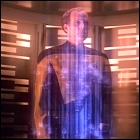 Realm Of Fear – it’s basically the Star Trek version of the Twilight Zone classic Nightmare At 40,000 Feet, sure, but it’s perfectly assembled from a visual standpoint, and Bole is able to pull off the improbable feat of making a chromakey hand puppet, er, ahem, organic masses in the matter stream, look scary as hell.
Realm Of Fear – it’s basically the Star Trek version of the Twilight Zone classic Nightmare At 40,000 Feet, sure, but it’s perfectly assembled from a visual standpoint, and Bole is able to pull off the improbable feat of making a chromakey hand puppet, er, ahem, organic masses in the matter stream, look scary as hell.
Starship Mine – Starship Mine is no Die Hard, and Cliff Bole is no John McTiernan. Patrick Stewart is no Bruce 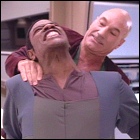 Willis (though these days one might actually be hard-pressed to tell the two apart in certain situations, what with Willis getting progressively older and Stewart somehow remaining ageless). There’s no attempt to disguise the fact that this is Die Hard In Space, and yet it’s still fun to watch – and it’s a revelation how different everything looks if they turn down the lights aboard the Enterprise. The lower lighting should, in theory, make everything smaller and more claustrophobic, but the direction gives everything an unexpected sweep and a scope. Paradoxically, the standing sets look bigger and smaller at the same time. Neat trick.
Willis (though these days one might actually be hard-pressed to tell the two apart in certain situations, what with Willis getting progressively older and Stewart somehow remaining ageless). There’s no attempt to disguise the fact that this is Die Hard In Space, and yet it’s still fun to watch – and it’s a revelation how different everything looks if they turn down the lights aboard the Enterprise. The lower lighting should, in theory, make everything smaller and more claustrophobic, but the direction gives everything an unexpected sweep and a scope. Paradoxically, the standing sets look bigger and smaller at the same time. Neat trick.
Cold Fire – leaping ahead a few years to Voyager, this is one of those episodes that must 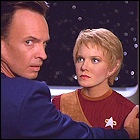 surely portend major implications for upcoming storylines… and… the ball gets dropped. Effects had advanced enough – and restrictions on the “house shooting style” loosened up enough – that Cliff Bole was able to do some really ineteresting stuff with an episode that’s basically a money-saving “guest star of the week comes aboard the ship and stays within the standing sets” show. None of Bole’s Voyager or DS9 work was strongly reminiscent of his TNG work – both shows had a much more expansive (and undoubtedly expensive) style that came from listening to TNG’s frequent-flyer directors saying “Here’s what we were able to do with non-wild sets stuck under a fixed lighting grid. Imagine what visually arresting stuff we could do if you made the sets easier to work in and stopped throwing buckets of light at everything.”
surely portend major implications for upcoming storylines… and… the ball gets dropped. Effects had advanced enough – and restrictions on the “house shooting style” loosened up enough – that Cliff Bole was able to do some really ineteresting stuff with an episode that’s basically a money-saving “guest star of the week comes aboard the ship and stays within the standing sets” show. None of Bole’s Voyager or DS9 work was strongly reminiscent of his TNG work – both shows had a much more expansive (and undoubtedly expensive) style that came from listening to TNG’s frequent-flyer directors saying “Here’s what we were able to do with non-wild sets stuck under a fixed lighting grid. Imagine what visually arresting stuff we could do if you made the sets easier to work in and stopped throwing buckets of light at everything.”
And yes, Cliff Bole directed The Best Of Both Worlds. Compared to most other Trek two-parters, which often had two different directors (and sometimes stories where part one was written by an entirely different set of writers from part two), The Best Of Both Worlds is an oddball: three behind-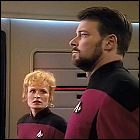 the-scenes figures can each claim sole authorship of some aspect of it – Michael Piller wrote both scripts, Bole directed both episodes, and Ron Jones scored both episodes. It’s no small wonder that CBS finally did what some of us amateur video editors had been doing for years: gluing both episodes together (for BluRay release) because they were that cohesive. As much as I like the whole package, I did not list it in Bole’s “top ten” because part one suffered badly from being the “holy crap, we ran out of money at the end of the season!” episode. The result was a script that made no allowances for the kind of action that such a momentous showdown demanded. Bole had demonstrated outstanding action sense with episodes like The Hunted and Conspiracy. but due to the budgetary limitations, The Best Of Both Worlds is stultifyingly limited to the Enterprise pulling up to the Borg ship, putting it in park, and opening fire. The character moments are near-flawless, and under Bole’s direction, Elizabeth Dennehy as Shelby tops the list of “why the hell didn’t they bring this character back?” guest stars of TNG. But as important as it is in hindsight, The Best Of Both Worlds came with a clamped-down budget that simply didn’t let the director make it the best-looking pair of episodes of the entire series. There just wasn’t the kind of money needed to have the Enterprise doing barrel rolls to get away from the Borg, or to make the interior sets look as though the ship had gotten the crap kicked out of it. Though universally loved, the episodes are far from perfect – Bole turned in far superior episodes both before and after it.
the-scenes figures can each claim sole authorship of some aspect of it – Michael Piller wrote both scripts, Bole directed both episodes, and Ron Jones scored both episodes. It’s no small wonder that CBS finally did what some of us amateur video editors had been doing for years: gluing both episodes together (for BluRay release) because they were that cohesive. As much as I like the whole package, I did not list it in Bole’s “top ten” because part one suffered badly from being the “holy crap, we ran out of money at the end of the season!” episode. The result was a script that made no allowances for the kind of action that such a momentous showdown demanded. Bole had demonstrated outstanding action sense with episodes like The Hunted and Conspiracy. but due to the budgetary limitations, The Best Of Both Worlds is stultifyingly limited to the Enterprise pulling up to the Borg ship, putting it in park, and opening fire. The character moments are near-flawless, and under Bole’s direction, Elizabeth Dennehy as Shelby tops the list of “why the hell didn’t they bring this character back?” guest stars of TNG. But as important as it is in hindsight, The Best Of Both Worlds came with a clamped-down budget that simply didn’t let the director make it the best-looking pair of episodes of the entire series. There just wasn’t the kind of money needed to have the Enterprise doing barrel rolls to get away from the Borg, or to make the interior sets look as though the ship had gotten the crap kicked out of it. Though universally loved, the episodes are far from perfect – Bole turned in far superior episodes both before and after it.
As the director of several episodes out of each season of 26 episodes, Cliff Bole held considerable sway over the visual style of ST:TNG. He’s one of the architects of the show’s look-and-feel, and had enough of a rapport with cast and crew alike that the Bolians were named after him (to say nothing of a throwaway DS9 line in which Sisko remembers “climbing the cliffs of Bole”). That’s a sign that, more than just being a director who could consistently bring in a decent-looking show under budget, he was a favorite with all involved. I always looked forward to see his name pop up in the credits again.
My glass is raised to one of TNG’s quintessential directors, no longer with us. And I have a feeling a Trek marathon will shortly follow.

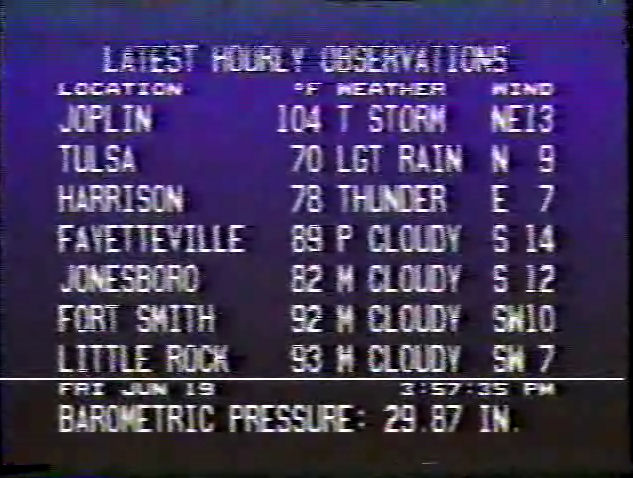
+ There are no comments
Add yours